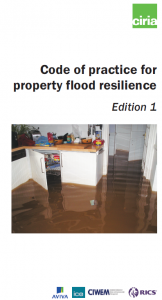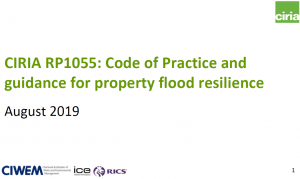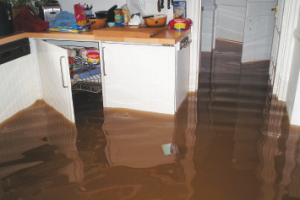CIRIA C790 – Code of practice for property flood resilience
Read and download these documents from the CIRIA website

Property flood resilience (PFR) is an important part of the response to flood risk. PFR includes measures that provide a way to reduce the risks to people and property enabling households and businesses to reduce flood damage, speed up recovery and reoccupation of flooded buildings. PFR measures should reduce the amount of water entering buildings (known as resistance measures), or limit the damage caused if water does enter a building (known as recoverability measures).
This Code of Practice (CoP) is concerned with PFR measures that can be introduced to buildings at risk from flooding. Often these measures can be installed as part of the repair of buildings after they have been flooded. However, some property owners may wish to be proactive and fit measures in anticipation of a flood.
The PFR CoP is made up of six standards:
1. Hazard assessment
A flood hazard assessment is undertaken to understand how flooding may threaten a property, and shall include:
- likelihood of flooding in the property location (and surrounding areas)
- nature of the flooding that could potentially occur
- likely frequency of flood events for the location (including potential for increased frequency due to climatic change and/or urban development)
- susceptibility of the property and its building(s) to flooding, given its surroundings, design, structure, materials used, condition, and adaptations.
Aim
PFR Standard 1 shall deliver a property level flood risk assessment, which clearly summarises the available hazard information to determine the likelihood and severity of flooding from different sources. This information will be used to inform the selection and design of PFR measures.
2. Property survey
The identification and delivery of PFR relies upon information provided by a suitably detailed survey of the building(s) at the property. The design, materials, condition, orientation, and exposure of buildings will vary greatly and a survey, unique to each building, is a critical element to identifying suitable resilience measures.
Aim
PFR Standard 2 requires that an appropriate survey of the property and end-user requirements is carried out. The purpose of the survey is to assess the current level of flood resilience of the property to provide the necessary information for the identification of the PFR options suitable for the property. Each building and structure at the property shall be surveyed.
3. Options development
Following achievement of PFR Standards 1 and 2, the options for implementing PFR are set out. The possibilities are discussed with the end user and the most appropriate PFR measures are selected and specified for implementation.
Aim
PFR Standard 3 allows options for PFR to be identified and considered. There options shall reflect the outcomes from Standards 1 and 2, and PFR measures suitable for the property. The options for PFR will consider the use of:
- measures that restrict water entry to the building under defined conditions
- materials that are recoverable after water contact
- services, fixtures and fittings that are recoverable by their locations and/or ability to resist water damage.
The design and specification will be based on the information provided by Standard 1 and 2, and the measures specified shall be selected impartially.
4. Construction
The achievement of the specification outcomes depends on the construction activity and installation of PFR measures. Ultimately, the quality of construction will help to ensure that the PFR measures installed will deliver the levels of resistance and recoverability required to meed the needs of both the building(s) and end users. This will then provide confidence to the end user and those providing insurance and/or maintenance to the building(s).
Aim
PFR Standard 4 ensures that the construction works deliver the benefits anticipated from the specified PFR measures, which are as a result of PFR Standard 3 outcomes.
5. Commissioning and handover
An important element of any construction project is commissioning and handover. These elements demonstrate that the construction activity undertaken, and the measures installed within the property deliver the levels of PFR required by the end user. It also sets out all operational and maintenance requirements of the PFR measures installed.
Aim
PFR Standard 5 ensures that the completed PFR construction work will operate effectively as designed, and that the end user has all relevant information and has been instructed in any development, operation and maintenance requirements.
6. Operation and maintenance
Properties with a defined flood risk are likely to remain at risk over time. It is possible for the level of risk to the property to increase due to factors such as climate change and urbanisation. To maintain a level of protection to a property, the PFR measures installed should be operated and maintained following the guidance provided in the handover pack.
Aim
PFR Standard 6 ensures that the completed PFR construction works are properly operated and maintained, and that any demountable measures are stored correctly. Note that the responsibilities and duties for operation and maintenance are defined as part of meeting the requirements of Standard 2.
CIRIA RP1055 – Code of Practice and guidance for property flood resilience
 Property flood resilience (PFR) is an important part of our response to managing flood risk. CIRIA together with a consortium led by BRE is managing a project to develop a robust and authoritative code of practice (CoP) and consolidated guidance that provides a standardised approach for the delivery and management of PFR.
Property flood resilience (PFR) is an important part of our response to managing flood risk. CIRIA together with a consortium led by BRE is managing a project to develop a robust and authoritative code of practice (CoP) and consolidated guidance that provides a standardised approach for the delivery and management of PFR.

